|
Related FAQs: TWA
Invertebrates, Fishes of the Tropical
West Atlantic, Tropical West Atlantic
2,
Related Articles: Algae,
Vascular Plants, Introduction
to Fishwatcher's Guide Series Pieces/Sections, Lachnolaimus maxiumus/Hogfish, Hogfishes of the Genus
Bodianus,
Invertebrates, Algae and Vascular
Plants of The Tropical West Atlantic: Bahamas to Brazil, Part
9
To: Part 1, Part 2, Part 3,
Part 4, Part
5, Part 6, Part 7, Part 8,
Part 10, Part
11, Part 12, Part 13, Part 14,
Part 15,
|
|
| Bob Fenner |
|
Order Antipatharia: Black Corals, Thorny Corals
| Antipathes sp. Bushy Black Coral. Finely
branched to the point of bushiness. Colored gold to brownish.
Circumtropical genus. N. Sulawesi pix. |
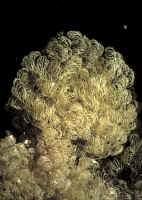 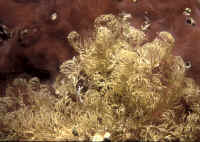
|
| Cirripathes (Stichopathes) leutkeni, Wire
Coral. Tropical West Atlantic. Up to fourteen feet in length.
Cozumel image. |

|
Worms:
Polychaetous
Annelids aka Bristleworms, Featherdusters... to aquarists are
sub-divided into two sub-classes:
| A) Errantia: Characteristics include numerous, similar
segments, well-developed lateral processes (parapodia, acicula,
setae). Have definitive "heads" with a pharynx with jaws
or teeth. Include swimming (six pelagic families!), crawling,
burrowing and tube-dwelling members. A member of this group in
question: Hermodice canunculata, a larger species of
" Bristleworm".
. |
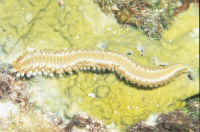
|
| B) Sedentaria: Polychaetes that commonly display a high
degree of segmental differentiation; parapodia reduced, without
specialized acicula or setae, prostomium (head) without sensory
structures but with tentacles and palps, other feeding structures.
No teeth or jaws present! Several families including the two
commonly included in the trade and hobby as fan and feather duster worms, mainly (there are
others): i. Sabellidae with
non-calcareous tubes. See example species below. ii.
Serpulidae with calcareous tubes
(Spirobranchus gigantea at right) |
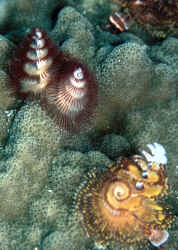
|
Errantiate Polychaetes:
| Hermodice canunculata, a larger species of
"Bristleworm". Large pleated structures (caruncle) on all
segments denote this too common, out and about species in the
tropical West Atlantic. Family Amphinomidae. Four to six inches
total length. Often found feeding on gorgonians, anemones, hard
corals. Close-up to show you part of the "fire", the
sharp bristles that make up the podia on each segment of the body.
Bahamas, Cancun and Cozumel images. |
Sedentariate Polychaetes: Featherdusters, Tubeworms...
| Anamobaea onstedii, the Split-Crown Feather
Duster, family Sabellidae. Radioles in a radial arrangement,
bilaterally symmetrically marked. Soft tubes generally unexposed.
Found solitary or in small groups. Belize and Bonaire
pix. |
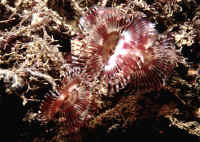 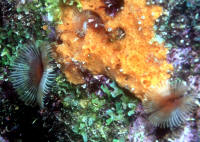
|
| Bispira variegata, Variegated Feather Duster
Worms, Family Sabellidae. Tropical west Atlantic. 3/4- 1 1/2"
in size. Parchment tubes usually hidden below grade, in which they
rapidly retreat if disturbed. Here in the sand in Bonaire. |
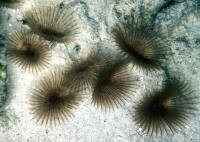 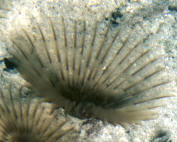
|
| Bispira brunnea, Social Feather Duster
Worms, Family Sabellidae. Come in whites, pink, purple and
brown-banded varieties/colors. Groups in the Bahamas and
Cozumel. |
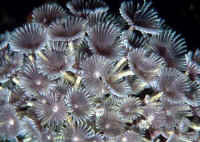 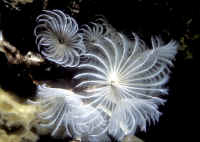
|
To: Part 1, Part
2, Part 3, Part
4, Part 5, Part
6, Part 7, Part
8, Part 10, Part
11, Part 12, Part
13, Part 14, Part
15,
|
|

